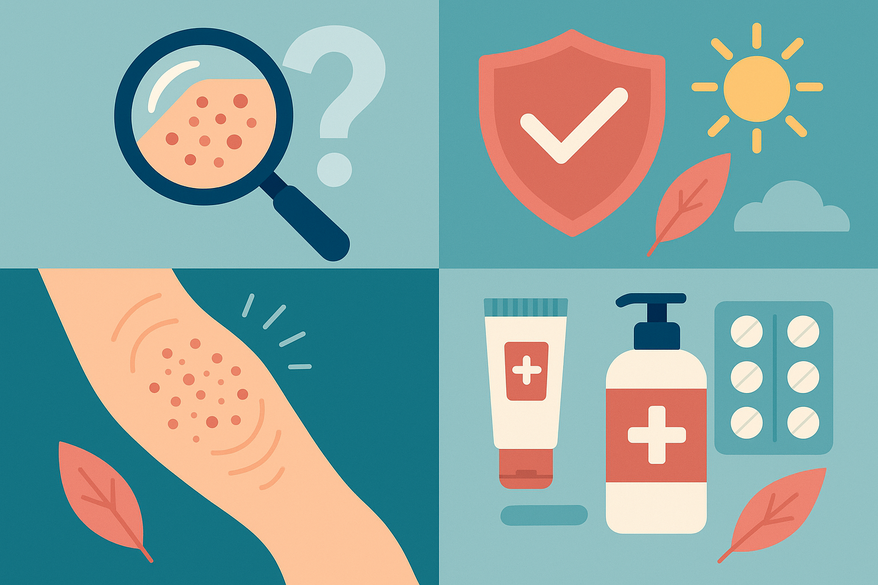Comprehensive Elderly Rash Treatment: Causes, Symptoms, and Prevention
Discover effective elderly rash treatment strategies, including causes, symptoms, and prevention tips, to manage aging skin and improve comfort.

Estimated reading time: 12 minutes
Key Takeaways
- Age-related vulnerabilities: Thin, dry skin and weakened immunity increase rash risk.
- Diverse causes: Allergies, infections, chronic diseases, medications, and environmental factors.
- Early recognition: Identify red flags like fever, pus, or mucous membrane involvement.
- Multimodal treatment: Home remedies, OTC products, prescription therapies, and lifestyle adjustments.
- Prevention and monitoring: Consistent skincare routine, humidity control, diet, and digital tracking tools.
Table of Contents
- Understanding Rashes in Older Adults
- Common Causes of Rashes
- Recognizing Symptoms and Red Flags
- Treatment Options
- Managing Underlying Conditions
- Prevention Strategies
- Conclusion
- Additional Resources
- FAQ
Understanding Rashes in Older Adults
Aging brings many changes to the skin. Reduced immunity, thinner epidermis, and multiple chronic conditions all contribute to increased rash frequency and severity in seniors. Chronic illnesses like diabetes and vascular disease compromise blood flow and healing, while polypharmacy raises the risk of drug-induced sensitivities.
Key factors include:
- Weakened immunity: Lower defenses make infections and inflammation more likely.
- Thinned barrier: Less cushioning and moisture increase friction, cracking, and itch.
- Comorbidities & medications: Diabetes, vascular issues, and new prescriptions can trigger or worsen rashes.
Real-World Tip: Review new medications with a physician if a stubborn rash appears—sometimes a simple change resolves the irritation.
Common Causes of Rashes
Accurate diagnosis is the first step in targeted treatment. Common triggers in seniors include:
- Allergic reactions: Contact dermatitis from soaps or fabrics; drug allergies to antibiotics, NSAIDs, and more.
- Infections: Bacterial (impetigo, cellulitis), viral (shingles), and fungal (candida, tinea) sources.
- Chronic skin diseases: Atypical eczema, plaque psoriasis, and seborrheic dermatitis presentations.
- Medication side effects: Maculopapular rashes and photosensitivity from antibiotics, diuretics, chemotherapy agents.
- Environmental and lifestyle triggers: Dry air, harsh cleansers, coarse fabrics, and pressure injuries.
Action Step: Keep a daily rash journal to note new products or exposures and identify possible allergens.
Recognizing Symptoms and Red Flags
Early detection of concerning signs guides urgent care.
- Typical symptoms: Redness, itching, burning, dryness, scaling, blisters.
- Red flags: Involvement of eyes, mouth, genitals; signs of infection (pus, warmth, fever); rapidly spreading rash; systemic symptoms like breathing difficulty or confusion.
If a red flag appears, seek medical evaluation immediately to prevent complications such as cellulitis or systemic infection.
Treatment Options
An effective regimen blends home strategies, OTC products, prescriptions, and non-drug measures.
- Home remedies & OTC: Fragrance-free emollients, colloidal oatmeal baths, calamine lotion, low-potency hydrocortisone. For more options, see best anti-itch cream solutions.
- Prescription therapies: Topical corticosteroids (Class I–VII), systemic antibiotics, antivirals (acyclovir), immunosuppressants tailored to renal function.
- Non-pharmacological: Moisturize within three minutes of bathing, use humidifiers, short lukewarm showers, scratch prevention, breathable natural fibers.
Monitoring & Safety: Regular medication reviews, watch for steroid side effects, and coordinate lab assessments as needed.
Managing Underlying Conditions
Comprehensive care must address comorbidities and medication interactions.
- Comorbidity impact: Diabetes impairs healing; venous insufficiency leads to stasis dermatitis; immune compromise alters rash patterns.
- Polypharmacy review: Reconcile medications, substitute high-risk drugs, and taper treatments under supervision.
- Collaborative model: Dermatologists, primary providers, pharmacists, and caregivers working in concert ensure the best outcomes.
Real-Life Example: Switching an ACE inhibitor to a calcium channel blocker resolved a severe rash in a senior with hypertension and psoriasis.
Prevention Strategies
Maintaining a strong skin barrier and healthy lifestyle is key to preventing rashes.
- Hydration & nutrition: Drink ample water; limit dehydrating beverages; consume vitamin E and omega-3 rich foods.
- Routine care: Bathe 2–3 times weekly with lukewarm water; apply oil-based moisturizers immediately; use mild, fragrance-free cleansers.
- Environmental controls: Keep indoor humidity at 30%–50%; avoid temperature extremes; apply broad-spectrum SPF 30+ outdoors.
- Digital tracking: Photograph persistent rashes and track rash progress effectively using tools like Best Skin Tracking App.
With Rash Detector, caregivers can upload images and track changes over time using AI-driven reports.

Conclusion
Aging skin requires special attention. Effective elderly rash treatment hinges on early recognition, trigger avoidance, and a blend of home, OTC, and prescription therapies. Coordinated care and preventive routines—hydration, diet, skincare, and digital monitoring—empower seniors to maintain comfort and skin health. Consult a healthcare professional for persistent or worsening rashes and personalized treatment plans.
Additional Resources
- American Academy of Dermatology (AAD) – Patient guides on rash care
- Cleveland Clinic Health Library – Rashes and red skin overview
- Pavilion Health Today – Geriatric dermatoses overview
- Number Analytics – Ultimate guide on geriatric dermatoses
- Health in Aging – Caregiver guide to skin problems
FAQ
- How can I tell if a rash in an older adult is serious?
Look for red flags such as fever, pus, rapid spread, or involvement of sensitive areas; seek immediate medical care. - What daily habits help prevent skin rashes in seniors?
Maintain adequate hydration, use gentle cleansers, moisturize regularly, control indoor humidity, and wear breathable clothing. - When should I consult a dermatologist?
If a rash persists beyond two weeks, recurs frequently, or fails to respond to home and OTC treatments, schedule a dermatology evaluation.





